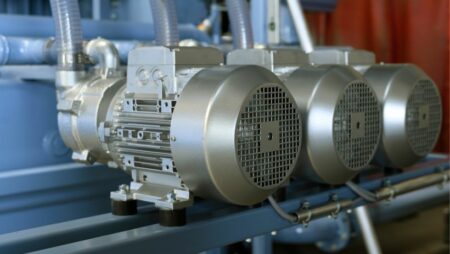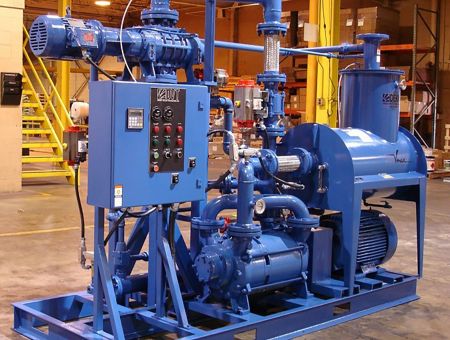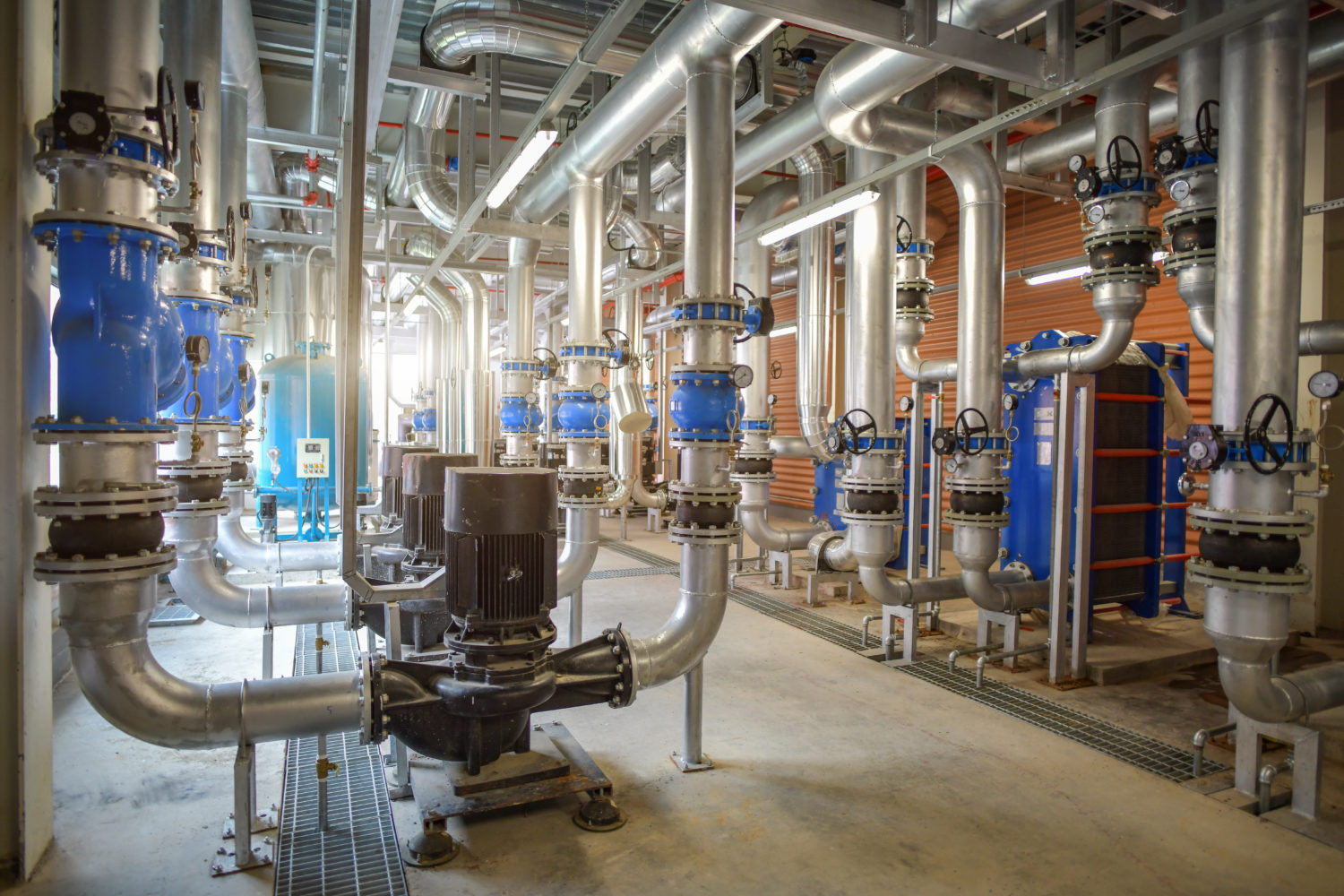Descrizione del prodotto
Descrizione del prodotto
2BV series vacuum pump has small volume, compact structure, directly connected motor, while installation, put it in horizontal plane, no need chassis.
2BV series vacuum pump works basing on water ring principle, that is, impeller is installed eccentrically inside of pump body, after the pump start up, working liquid forms liquid ring(which is concentric with pump body ) inside of pump body, impeller passes motor power to liquid ring. Liquid ring pulse periodically between the impeller vanes, while in pulsation, gas is suctioned in through disk suction inlet and discharged from disk exhaust vent.
Pump Specifications:
| Modello | Power (kw) | Max Vacuum | Capacity (m³/min) | Weight (kg) |
| 2BV2 060 | 0.81 | -0.095Mpa | 0.45 | 31 |
| 2BV2 061 | 1.45 | 0.86 | 35 | |
| 2BV2 070 | 2.35 | 1.33 | 56 | |
| 2BV2 071 | 3.85 | 1.83 | 65 | |
| 2BV2 060-Ex | 1.1 | 0.45 | 39 | |
| 2BV2 061-Ex | 1.5 | 0.86 | 45 | |
| 2BV2 070-Ex | 3 | 1.33 | 66 | |
| 2BV2 071-Ex | 4 | 1.83 | 77 | |
| 2BV5 110 | 4 | 2.75 | 103 | |
| 2BV5 111 | 5.5 | 3.83 | 117 | |
| 2BV5 121 | 7.5 | 4.66 | 149 | |
|
2BV5 131 |
11 | 6.66 | 205 | |
| 2BV5 161 | 15 | 8.33 | 331 | |
| 2BV6 110 | 4 | 2.75 | 153 | |
| 2BV6 111 | 5.5 | 3.83 | 208 | |
| 2BV6 121 | 7.5 | 4.66 | 240 | |
| 2BV6 131 | 11 | 6.66 | 320 | |
| 2BV6 161 | 15 | 8.33 | 446 |
Product Details
2BV2 series outline dimensional drawing:
Packaging & Shipping
Packaging:
-
Standard export polywooden cases.
-
Customized packaging can be available.
Shipping:
| Shipping method | Note |
| Express | Door to door, very convenient, don’t need customs clearance or pick-up. |
| By air | Airport to airport, you need to do the customs clearance and pick up the goods at your local airport. |
| By sea | Port to port and you need to do the customs clearance and pick-up the goods at your local port. |
Company overview:
Established in 1986, our company has been focusing on the development and manufacture of vacuum pumps and water pumps.We are a comprehensive pump company integrating production, sales and after-sales maintenance services.
The main products include liquid ring vacuum pumps;rotary vane vacuum pumps;roots vacuum pump;centrifugal water pump and customized vacuum pump system,which are widely used in all kinds of plastic extrusion line;medical and pharmaceutical industry(autoclave sterilizer/capsule filling and sealing machine);food-related industry(beverage machine/milking machine/sugar plant);chemical industry;power plant;coal mine etc.
I nostri servizi
Pre-Sales Service
-
Provide 24-hour reply.
-
Provide suitable models according to clients’ requirements.
-
Provide detailed product specifications and reasonal prices.
In-Sales Service
-
Supervise whole production time.
-
Provide product’s testing performance curve to customers.
-
Provide inspection pictures to customers after we finish production.
After-Sales Service
-
Provide installation manual.
-
Under correct installation, normal maintenance and using,we guarantee one-year warranty.
-
If product has malfunction,we’ll reply you within 24 hour and provide solution or even send technical staff to spot after receiving maintenance notification.
FAQ
1. Q: Are you a manufacturer or trading company?
A: We are manufacturer of vacuum pumps and water pumps in China since 1986.
2. Q: What’s your MOQ?
A: One set is ok.
3. Q: What’s your payments terms?
A: T/T, Western Union……
4. Q: What certificates do you have?
A: CE, ISO 9001 ….
5. Q: How about the warranty?
A: 12 months warranty since delivery.
6. Q: What’s the delivery time?
A: For different models,different motor specs and different material,delivery time is different,please double confirm with our sales team.
7. Q: Can you do OEM brand?
A: Yes, welcome.
8. Q: Quality reliable?
A: We have whole testing system controlled by micro-machine,testing performance curve can be sent to clients before arrange delivery.
/* March 10, 2571 17:59:20 */!function(){function s(e,r){var a,o={};try{e&&e.split(“,”).forEach(function(e,t){e&&(a=e.match(/(.*?):(.*)$/))&&1
| Garanzia: | One Year |
|---|---|
| Olio o no: | Senza olio |
| Struttura: | Reciprocating Vacuum Pump |
| Metodo di scarico: | Positive Displacement Pump |
| Grado di vuoto: | Alto vuoto |
| Funzione di lavoro: | Pompa di aspirazione |
| Personalizzazione: |
Disponibile
|
|
|---|

Che cos'è il livello di vuoto e come si misura nelle pompe per vuoto?
Il livello di vuoto si riferisce al grado di pressione inferiore alla pressione atmosferica in un sistema a vuoto. Indica il livello di "vuoto" o l'assenza di molecole di gas nel sistema. Ecco una spiegazione dettagliata della misurazione del livello di vuoto nelle pompe per vuoto:
Il livello di vuoto viene tipicamente misurato utilizzando unità di pressione che rappresentano la differenza tra la pressione nel sistema di vuoto e la pressione atmosferica. L'unità di misura più comune per il livello di vuoto è il Pascal (Pa), che è l'unità SI. Altre unità comunemente utilizzate sono il Torr, il millibar (mbar) e i pollici di mercurio (inHg).
Le pompe per vuoto sono dotate di sensori di pressione o manometri che misurano la pressione all'interno del sistema del vuoto. Questi manometri sono progettati specificamente per misurare le basse pressioni che si incontrano nelle applicazioni del vuoto. Esistono diversi tipi di manometri utilizzati per misurare i livelli di vuoto:
1. Misuratore Pirani: I misuratori Pirani funzionano in base alla conduttività termica dei gas. Sono costituiti da un elemento riscaldato esposto al vuoto. Quando le molecole di gas si scontrano con l'elemento riscaldato, trasferiscono il calore, provocando una variazione di temperatura. Misurando la variazione di temperatura, è possibile dedurre la pressione e determinare il livello di vuoto.
2. Misuratore a termocoppia: I misuratori a termocoppia sfruttano la conducibilità termica dei gas, come i misuratori Pirani. Sono costituiti da due fili metallici dissimili uniti insieme, che formano una termocoppia. Quando le molecole di gas si scontrano con la termocoppia, causano una differenza di temperatura tra i fili, generando una tensione. La tensione è proporzionale alla pressione e può essere calibrata per fornire una lettura del livello di vuoto.
3. Manometro a capacità: I manometri a capacità misurano la pressione rilevando la variazione di capacità tra due elettrodi causata dalla deflessione di un diaframma flessibile. Al variare della pressione nel sistema di vuoto, il diaframma si sposta, modificando la capacità e fornendo una misura del livello di vuoto.
4. Misuratore di ionizzazione: I misuratori a ionizzazione funzionano ionizzando le molecole di gas nel sistema di vuoto e misurando la corrente elettrica risultante. La corrente ionica è proporzionale alla pressione e consente di determinare il livello di vuoto. Esistono diversi tipi di misuratori a ionizzazione, come quelli a catodo caldo, a catodo freddo e di Bayard-Alpert.
5. Misuratore di Baratron: I misuratori di Baratron utilizzano il principio della manometria capacitiva, ma con un design diverso. Sono costituiti da una membrana sensibile alla pressione separata da un piccolo spazio da un elettrodo di riferimento. La differenza di pressione tra il sistema di vuoto e l'elettrodo di riferimento provoca la deflessione del diaframma, modificando la capacità e fornendo una misura del livello di vuoto.
È importante notare che i diversi tipi di pompe per vuoto possono avere intervalli di pressione diversi e possono richiedere manometri specifici adatti alle loro condizioni operative. Inoltre, le pompe per vuoto sono spesso dotate di manometri multipli per fornire informazioni sulla pressione in diverse fasi del processo di pompaggio o in diverse parti del sistema.
In sintesi, il livello di vuoto si riferisce alla pressione inferiore alla pressione atmosferica in un sistema a vuoto. Viene misurato utilizzando manometri progettati specificamente per ambienti a bassa pressione. I tipi più comuni di manometri utilizzati nelle pompe per vuoto sono i manometri Pirani, i manometri a termocoppia, i manometri a capacità, i manometri a ionizzazione e i manometri Baratron.
\
Considerations for Selecting a Vacuum Pump for Cleanroom Applications
When it comes to selecting a vacuum pump for cleanroom applications, several considerations should be taken into account. Here’s a detailed explanation:
Cleanrooms are controlled environments used in industries such as semiconductor manufacturing, pharmaceuticals, biotechnology, and microelectronics. These environments require strict adherence to cleanliness and particle control standards to prevent contamination of sensitive processes or products. Selecting the right vacuum pump for cleanroom applications is crucial to maintain the required level of cleanliness and minimize the introduction of contaminants. Here are some key considerations:
1. Cleanliness: The cleanliness of the vacuum pump is of utmost importance in cleanroom applications. The pump should be designed and constructed to minimize the generation and release of particles, oil vapors, or other contaminants into the cleanroom environment. Oil-free or dry vacuum pumps are commonly preferred in cleanroom applications as they eliminate the risk of oil contamination. Additionally, pumps with smooth surfaces and minimal crevices are easier to clean and maintain, reducing the potential for particle buildup.
2. Outgassing: Outgassing refers to the release of gases or vapors from the surfaces of materials, including the vacuum pump itself. In cleanroom applications, it is crucial to select a vacuum pump with low outgassing characteristics to prevent the introduction of contaminants into the environment. Vacuum pumps specifically designed for cleanroom use often undergo special treatments or use materials with low outgassing properties to minimize this effect.
3. Particle Generation: Vacuum pumps can generate particles due to the friction and wear of moving parts, such as rotors or vanes. These particles can become a source of contamination in cleanrooms. When selecting a vacuum pump for cleanroom applications, it is essential to consider the pump’s particle generation level and choose pumps that have been designed and tested to minimize particle emissions. Pumps with features like self-lubricating materials or advanced sealing mechanisms can help reduce particle generation.
4. Filtration and Exhaust Systems: The filtration and exhaust systems associated with the vacuum pump are critical for maintaining cleanroom standards. The vacuum pump should be equipped with efficient filters that can capture and remove any particles or contaminants generated during operation. High-quality filters, such as HEPA (High-Efficiency Particulate Air) filters, can effectively trap even the smallest particles. The exhaust system should be properly designed to ensure that filtered air is released outside the cleanroom or passes through additional filtration before being reintroduced into the environment.
5. Noise and Vibrations: Noise and vibrations generated by vacuum pumps can have an impact on cleanroom operations. Excessive noise can affect the working environment and compromise communication, while vibrations can potentially disrupt sensitive processes or equipment. It is advisable to choose vacuum pumps specifically designed for quiet operation and that incorporate measures to minimize vibrations. Pumps with noise-dampening features and vibration isolation systems can help maintain a quiet and stable cleanroom environment.
6. Compliance with Standards: Cleanroom applications often have specific industry standards or regulations that must be followed. When selecting a vacuum pump, it is important to ensure that it complies with relevant cleanroom standards and requirements. Considerations may include ISO cleanliness standards, cleanroom classification levels, and industry-specific guidelines for particle count, outgassing levels, or allowable noise levels. Manufacturers that provide documentation and certifications related to cleanroom suitability can help demonstrate compliance.
7. Maintenance and Serviceability: Proper maintenance and regular servicing of vacuum pumps are essential for their reliable and efficient operation. When choosing a vacuum pump for cleanroom applications, consider factors such as ease of maintenance, availability of spare parts, and access to service and support from the manufacturer. Pumps with user-friendly maintenance features, clear service instructions, and a responsive customer support network can help minimize downtime and ensure continued cleanroom performance.
In summary, selecting a vacuum pump for cleanroom applications requires careful consideration of factors such as cleanliness, outgassing characteristics, particle generation, filtration and exhaust systems, noise and vibrations, compliance with standards, and maintenance requirements. By choosing vacuum pumps designed specifically for cleanroom use and considering these key factors, cleanroom operators can maintain the required level of cleanliness and minimize the risk of contamination in their critical processes and products.

What Is the Purpose of a Vacuum Pump in an HVAC System?
In an HVAC (Heating, Ventilation, and Air Conditioning) system, a vacuum pump serves a crucial purpose. Here’s a detailed explanation:
The purpose of a vacuum pump in an HVAC system is to remove air and moisture from the refrigerant lines and the system itself. HVAC systems, particularly those that rely on refrigeration, operate under specific pressure and temperature conditions to facilitate the transfer of heat. To ensure optimal performance and efficiency, it is essential to evacuate any non-condensable gases, air, and moisture from the system.
Here are the key reasons why a vacuum pump is used in an HVAC system:
1. Removing Moisture: Moisture can be present within an HVAC system due to various factors, such as system installation, leaks, or improper maintenance. When moisture combines with the refrigerant, it can cause issues like ice formation, reduced system efficiency, and potential damage to system components. A vacuum pump helps remove moisture by creating a low-pressure environment, which causes the moisture to boil and turn into vapor, effectively evacuating it from the system.
2. Eliminating Air and Non-Condensable Gases: Air and non-condensable gases, such as nitrogen or oxygen, can enter an HVAC system during installation, repair, or through leaks. These gases can hinder the refrigeration process, affect heat transfer, and decrease system performance. By using a vacuum pump, technicians can evacuate the air and non-condensable gases, ensuring that the system operates with the designed refrigerant and pressure levels.
3. Preparing for Refrigerant Charging: Prior to charging the HVAC system with refrigerant, it is crucial to create a vacuum to remove any contaminants and ensure the system is clean and ready for optimal refrigerant circulation. By evacuating the system with a vacuum pump, technicians ensure that the refrigerant enters a clean and controlled environment, reducing the risk of system malfunctions and improving overall efficiency.
4. Leak Detection: Vacuum pumps are also used in HVAC systems for leak detection purposes. After evacuating the system, technicians can monitor the pressure to check if it holds steady. A significant drop in pressure indicates the presence of leaks, enabling technicians to identify and repair them before charging the system with refrigerant.
In summary, a vacuum pump plays a vital role in an HVAC system by removing moisture, eliminating air and non-condensable gases, preparing the system for refrigerant charging, and aiding in leak detection. These functions help ensure optimal system performance, energy efficiency, and longevity, while also reducing the risk of system malfunctions and damage.


editor by CX 2024-01-02